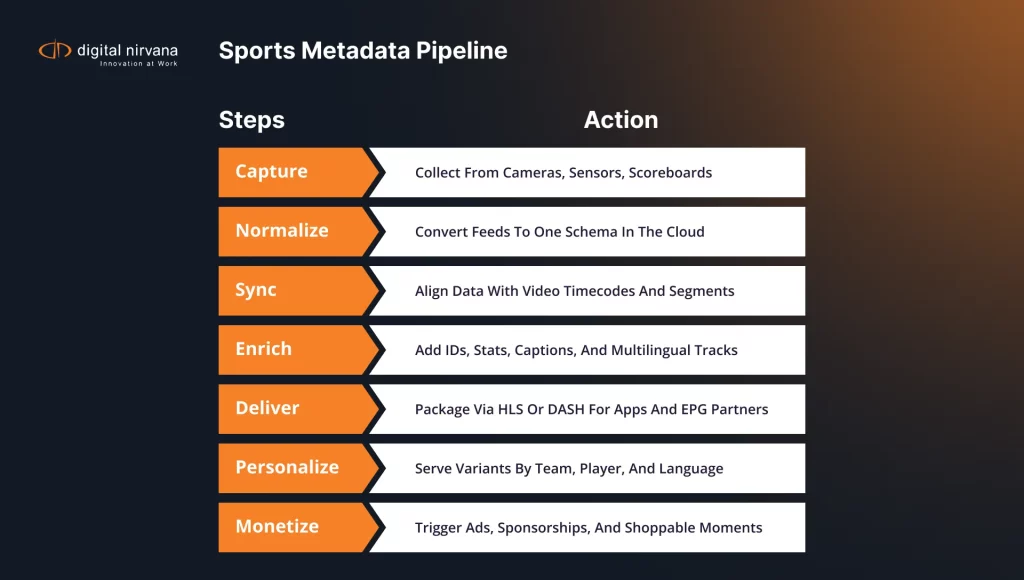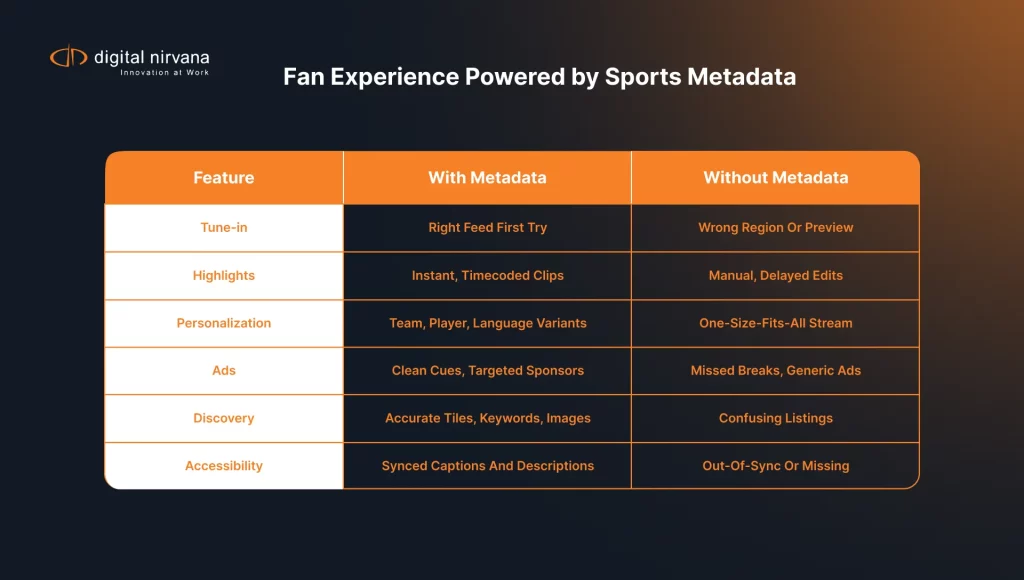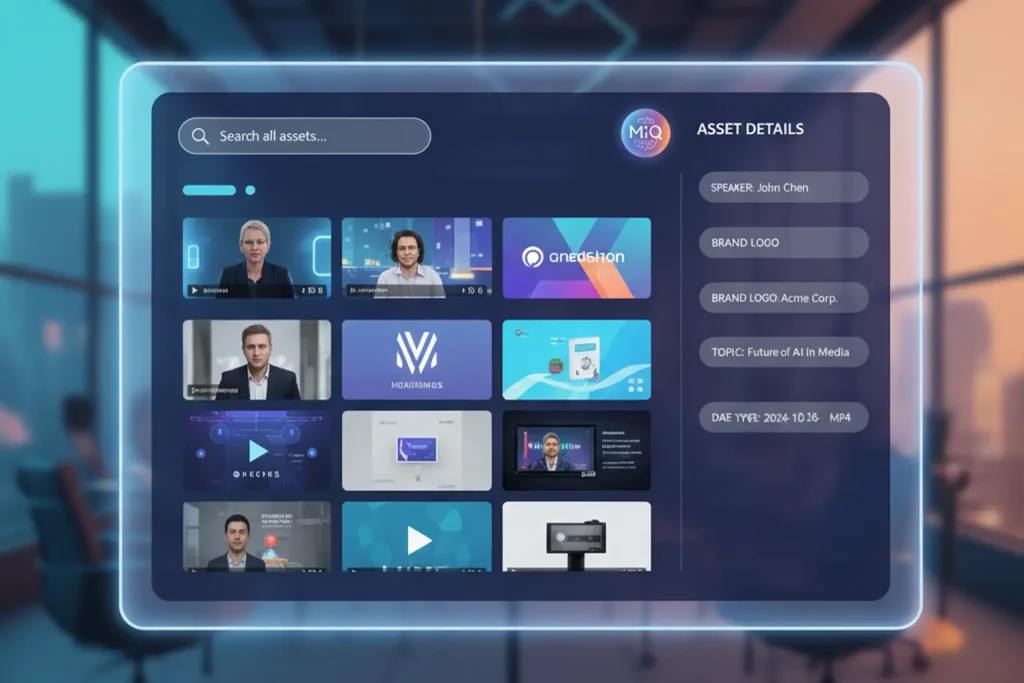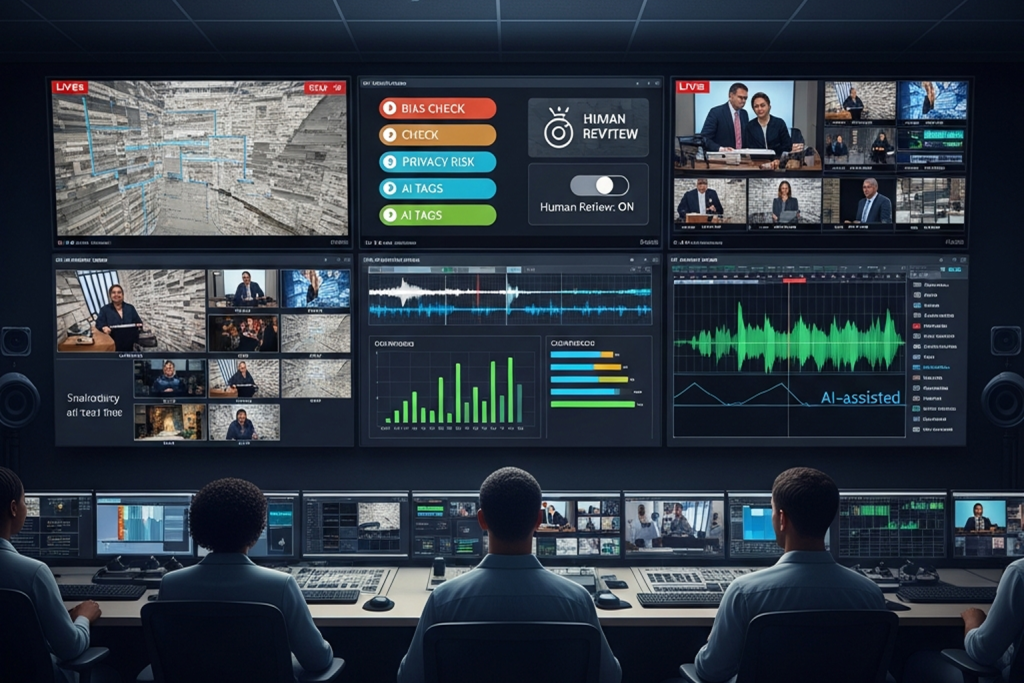Sports metadata now steers what fans see, when they see it, and how quickly they get there. Viewers jump straight to tipoff, a goal, or the ninth-inning rally because timed tags mark every big moment. Blackouts apply cleanly because policy data rides with the stream and tells apps what to show in each ZIP code. Personalized feeds surface the home commentary, Spanish audio, or a kids view in one tap. Live sports data enriches the screen with shot charts, win probabilities, and instant highlights that load in seconds. Sports Features built on structured Metadata flow through each API so apps and EPG partners can display the right tile in the right place. Strong Keywords, accurate Imagery, and clear Genres improve Discoverability across Listings and raise Viewership. Fans on YouTube, ESPN, and an SVOD service want fast Game Updates, Team Stats, and Game Stats that keep them in the moment. That is how Fan Engagement grows without guesswork.
What sports metadata means in live TV and streaming
Sports metadata describes the game, the feed, and the rules that govern delivery so every viewing experience stays accurate, fast, and compliant. In practice, sports metadata includes descriptive tags for teams and players, timed markers for plays and breaks, and policy data for rights and blackouts. Broadcasters and streamers use this data to label, route, personalize, and monetize the same live event across many platforms. Engineers wire these fields into production trucks, cloud encoders, manifests, and apps so the data stays aligned from camera to phone. Producers rely on it to clip, caption, and publish highlights without guesswork.

Descriptive tags that travel with the game
Descriptive tags identify the sport, league, season, teams, players, venue, round, and language so systems know what the content is. These tags enable faster search, better recommendations, and reliable playlist assembly across devices. When tags stay consistent, a replay from one provider matches a live feed from another, which keeps watch histories, favorites, and alerts accurate. Rich tags also improve assistive features such as screen readers and voice search because they expose clear names and roles. Clear, shared labels reduce manual re-tagging and save producers time during high-pressure moments.
Timed metadata for moments, plays, and breaks
Timed metadata pins events to exact timecodes so editors and apps can jump to the right frame. These markers flag the start of play, end of play, commercial breaks, coach’s challenges, penalties, and stoppages. With precise times, automation can assemble reels, chapterize game timelines, and trigger graphics at the right beat. Fans benefit because they can skip to key plays, while ad systems benefit because they insert spots only at clean splice points. Reliable timing prevents drift between captions, commentary, and on-screen stats, which preserves trust.
Rights and policy metadata that control delivery
Rights and policy metadata define where, when, and on which devices a feed can appear. This data covers blackouts, substitution rules, language restrictions, sponsor obligations, and accessibility requirements. Delivery systems read these fields to switch to alternates when a primary feed cannot play in a region. Policy tags also instruct apps on age gates and wagering visibility so user settings and local rules match what appears on screen. Clear rules cut support tickets and reduce legal risk during high-visibility games.
Metadata form, hierarchy, and folder design for clean operations
A practical Metadata Form, plus a clear Hierarchy and Folder structure, prevents chaos on game day. Producers pick from constrained lists for sport, league, Genres, and Organizations so names match across venues. Editors can file a Highlight Reel, Previews, and Match Previews into consistent Content Destinations without retyping IDs. That structure also helps APIs return predictable fields to client apps and EPG partners. Clean hierarchy makes search faster, reduces training time, and keeps late-night mistakes out of the broadcast.
Why sports metadata matters to U.S. audiences in 2025
In 2025, U.S. fans expect the right game, angle, and language with zero hunting, which makes sports metadata the backbone of a smooth experience. Schedules stack up across leagues and streaming apps, so audiences need better discovery that works in seconds. Personalization matters because a Knicks fan, a bilingual household, and a family with kids want different views of the same game. Churn drops when fans land on the correct feed the first time and stay engaged through breaks. Precise metadata powers all of it because it aligns content, rights, and UI logic in real time.
Faster tune-in and better discovery during crowded schedules
Discovery thrives when metadata delivers clear, structured clues to the app and the search engine. Good labels for team names, start times, and broadcast variants push the right tile to the top of the home screen. Rich snippets like “fourth quarter, tie game” keep users from bouncing to a rival app. Tune-in links that include the correct feed ID eliminate loops where fans land on a preview or an error. When the system knows exactly which stream matches a user’s intent, session starts rise and support chats fall. Pair strong Keywords with accurate Listings, consistent Imagery, and Genres so Discoverability improves across ESPN, YouTube, and SVOD service rows.
Personalized streams built on team, player, and language prefs
Personalization rests on first-party preferences combined with clean metadata. When an app stores favorite teams, languages, announcers, and camera angles, it can present the ideal feed at open. Player-centric tags power features like a star-mode stream that tracks a single athlete through iso cams, shot overlays, and on-bench audio. Language tags make it trivial to switch between English and Spanish audio without hunting a separate tile. Parents appreciate kid-friendly views that soften graphics and commentary while keeping real-time accuracy. Clear metadata makes all these variants predictable for QA and stable under load.
Lower churn when fans find the right feed the first time
Churn often starts with a miss: the wrong region, the wrong language, or a feed that buffers. Metadata fights those misses with precise IDs, policy flags, and time-aligned markers that remove ambiguity. When fans consistently land on the correct stream, they spend less time searching and more time watching. Engagement metrics climb because users stay through breaks and bounce less after ads. Over a season, these small wins compound into lower churn and higher lifetime value.
Core standards every sports broadcaster should know
For deeper context on platform choices and tooling for broadcasters, see our guide to metadata management solutions for broadcast teams.
Standards keep multi-partner workflows aligned so live sports data flows from stadium to screen without rework. Engineering teams should ground their pipelines in well-known specs that cover ad signaling, blackouts, IDs, and timed tags. Standards also help vendors interoperate, which reduces custom code and surprises during big events. When the industry speaks a common language, features ship faster and QA runs cleaner. Below are the core building blocks that matter most in 2025.
SCTE-35 for ad markers and clean switching
Reference: the official SCTE-35 standard defines ad cueing and splice behavior used across the industry.
SCTE-35 messages signal opportunities to insert ads and switch feeds without artifacts. Encoders embed these messages in the stream so downstream systems can act at the instant a break begins or a program resumes. Clear ad markers reduce slates, mistimed cuts, and double audio, which keeps viewers engaged through breaks. Metadata within the message can describe break duration, priority, and placement rules that ad servers honor. Broadcasters should test SCTE-35 handling across partners to confirm splices remain clean at scale.
In-band signaling and splice points
In-band signaling carries control information alongside audio and video so players do not guess when to cut. Splice points mark the exact frame where a transition should occur, which makes switching consistent across devices. Producers gain confidence because they know ad breaks and alternate feeds will trigger at the same moment everywhere. QA teams watch for edge cases such as late markers or encoder delays and correct them before air. Clean in-band signals translate into fewer complaints and higher ad delivery accuracy.
SCTE-224 for blackouts, substitutions, and regional rules
SCTE-224 provides a structured way to express rights, blackouts, substitutions, and device-level policies. It tells delivery systems when to block a primary feed and which alternate to show instead. This standard allows granular rules by ZIP, DMA, time window, and device class, which covers real broadcast scenarios. With clear policies, apps can comply without confusing the viewer or support team. Broadcasters should treat SCTE-224 as the source of truth for policy logic that changes by region.
Dynamic blackout rules and alternates
Dynamic blackout logic blends rights data with real-time availability so viewers always see something they can watch. When a blackout applies, the system pivots to a league-provided live look-in, a condensed game, or a studio show. Alternates keep the tile live and the viewer engaged rather than stuck on an error screen. Metadata records who saw what, which helps with makegoods and sponsor reporting. Over time, dynamic routing turns a compliance burden into an engagement tool.
ID3 and in-manifest tags for HLS and DASH
ID3 tags and in-manifest metadata carry small but critical context to the player while a stream runs. These tags can include score updates, play descriptors, ad cues, and UI hints. Because they travel inside or alongside the playlist, they arrive on time even at low latency. Lightweight tags keep apps responsive while heavier data travels over APIs in the background. Teams should design a consistent tag schema so different clients render the same experience.
Timed metadata in HLS playlists
Timed metadata in HLS appears as markers in playlists that align with segments and parts. This design supports instant seeking to plays and frame-accurate clipping in cloud editors. When producers publish a highlight, the player can stitch the correct segments without transcoding the whole game. Viewers benefit because scrubbing feels sharp and chapter jumps never miss the moment. Good hygiene around segment durations and discontinuities keeps the timing stable through overtime and weather delays.
EIDR, ISAN, and team or player IDs for universal search
Global identifiers like EIDR and ISAN give every program a stable ID, while sports-specific IDs tie teams and players to the event. These IDs help search engines, voice assistants, and partner apps recognize the same game across services. With consistent IDs, a user who searches by player can land on the correct stream regardless of which app they use. IDs also simplify cross-sell because a preseason game, a documentary, and a mic’d-up short can link back to one franchise. Treat IDs as permanent keys that connect your catalog.
Consistent IDs across apps and platforms
Consistency matters as much as the ID scheme itself. When IDs change between partners or over time, favorites break and analytics lose fidelity. A shared registry or mapping service keeps partners aligned through trades, team rebrands, and tournament ties. Product managers should assign ownership for ID governance so updates never slip during busy seasons. Stable IDs make every other personalization and discovery feature more reliable.
EPG and app store keywords for discoverability
EPG providers and app stores reward precise Keywords, Genres, and Images that match what viewers expect to see. Treat artwork and copy as part of your metadata so search rows surface the right game in time. Include short Match Previews with Team Stats and Game Statistics to help tiles win the click. Keep copy consistent across Destinations so ESPN, YouTube, and a regional SVOD service show the same facts. Small fixes here raise Viewership without new engineering.
From truck to app: the live sports data pipeline
A modern live pipeline collects, labels, verifies, and distributes live sports data from the venue to the viewer in seconds. Each leg of the chain must preserve timing and meaning so the content and the UI never drift. On the ground, sensors, cameras, and graphics systems create a rich telemetry layer. In the cloud, services normalize, enrich, and route that data to encoders, manifest packagers, and CDNs. Apps then render the right experience based on the viewer’s preferences and rights profile.

Capture at source with optical tracking and sensors
Capture starts at the venue with optical tracking, player wearables where allowed, scoreboard integrations, and officiating systems. These sources produce coordinates, velocities, possession states, penalties, and clock events that feed the production switcher. A small ingest edge processes raw signals into normalized events that the rest of the chain can understand. Engineers set guardrails for frame rate, resolution, and latency so capture meets the needs of downstream editors. The goal is consistent, low-latency data that reflects what cameras and referees see.
Normalize data in the cloud for speed and scale
Normalization turns varied venue feeds into one schema so developers do not write custom logic for every stadium. Cloud functions validate fields, convert units, assign IDs, and enrich with context such as standings or rivalry flags. Normalized data accelerates feature work because UI teams can depend on a stable contract. It also improves partner integrations since leagues and broadcasters can share one spec rather than many. Speed matters, so teams design stateless services that scale out during national games. Expose a stable API for internal tools and partner Organizations so integrations do not stall during playoffs.
Sync metadata to video timecodes across workflows
Synchronization aligns every event with the video timeline so editors, players, and ad systems act together. Timecode mapping links a play event to a segment boundary in the HLS or DASH manifest. When sync holds, an instant highlight exports the correct frames and captions stay readable through a fast break. Sync also protects ad delivery because breaks appear at the same moment the cue arrives. Without sync, even great features feel broken because the UI and the video disagree.
PTS alignment and time drift checks
Presentation Time Stamp alignment keeps audio, video, captions, and data marching in lockstep as the stream flows. Drift checks watch the delta between data arrivals and segment boundaries and correct issues before viewers notice. Engineers measure drift during overtime, weather pauses, and encoder restarts because those moments stress timing. Automated alerts flag anomalous gaps so operators can retrim or restart safely. A small investment in drift tooling pays off across every live game on the schedule.
Deliver over HLS or DASH with low-latency CMAF
Delivery hinges on HLS or DASH with low-latency CMAF so segments and parts arrive quickly without buffering. Encoders produce short parts, packagers publish updated playlists, and CDNs honor cache rules tuned for speed. Players that support partial segments render action faster and keep metadata aligned with the moving timeline. The net effect is a snappy stream where tags and visuals feel instant. Fans reward that speed with longer sessions and more replays. Publish to multiple Destinations and Content Destinations including owned apps, ESPN partner feeds, YouTube channels, and an SVOD service so every audience finds the game where they watch.
Live sports data that drives fan-facing features
For an implementation playbook that teams can adapt mid-season, review our article on AI metadata tagging.
Fans judge a service by the features they see and use, which makes live sports data an essential ingredient in the product. A healthy pipeline turns telemetry and tags into simple, helpful UI moments that reduce friction. Feature teams should focus on clarity and speed over novelty because fans value reliability during live play. Good features also respect different audiences, from diehards to kids, and let users choose without friction. Data should inform design decisions, not overwhelm the screen.

Alt broadcasts with coaching angles and kid-friendly views
Alternate broadcasts give audiences control without forcing a separate app. A coaching angle may overlay formations, route trees, or defensive heat maps at key moments. A kids view may tone down graphics, simplify stats, and highlight favorite players with fun avatars. These variants rely on metadata to pick the right cameras, graphics, and commentary in real time. When well executed, alternates broaden appeal and turn a single game into many tailored shows.
Interactive stats, shot charts, and win probability
Interactive layers let fans explore without pausing the game. Shot charts and drive maps update as plays occur, while win probability curves reflect each swing in momentum. These overlays should react to taps and remote clicks with quick tooltips and short explanations. A shared data model keeps numbers consistent across the scoreboard, the graphic, and the announcer’s script. Reliability builds trust, which keeps fans coming back for the next game night.
Instant highlights built from plays and thresholds
Instant highlights convert timed play events into short clips that load while the game continues. Trigger rules may include a threshold such as a three-point streak, a go-ahead goal, or a red-zone drive. Editors can override automation to craft a tighter cut or attach a storyline panel. A solid system publishes clips with captions, transcripts, and descriptive tags so they are discoverable minutes later. Fast, accurate highlights extend engagement during halftime and draw new viewers through social links. Package a Highlight Reel for YouTube while your app pushes bite-size clips to increase Viewership.
Watch-party overlays and real-time polls
Watch-party features overlay chat, emojis, polls, and trivia that match the live moment. Metadata about the current play, player, or break lets the UI launch the right prompt without delay. Social features should never obscure the action and should respond to a viewer’s role and settings. Sponsors can own a poll or a trivia round that aligns with a break, which turns fun into revenue. Done right, watch parties make a national game feel like a seat with friends.
Previews and match previews that set context
Short, structured Previews and Match Previews help new viewers decide to watch and help returning viewers jump back in. Pair head-to-head Team Stats and Game Statistics with storylines such as rivalries or injury news. Keep copy tight and place it near the play button so it speeds conversion. Update Previews during breaks with fresh Game Updates to keep tiles feeling alive. These small details pay off in click-throughs and Fan Engagement.
Monetization wins powered by metadata
For product packaging ideas and sales enablement checklists, see our post on metadata and content monetization strategies.
Metadata opens more ways to earn without bloating the screen or interrupting the game. Clean ad cues, precise IDs, and contextual tags give ad tech the signals it needs to deliver value. Campaigns can target by team, player, region, or moment, which raises relevance and CPMs. Commerce can tie gear and betting offers to the action that just happened. With strong governance, monetization grows while trust and compliance stay intact.
Dynamic ad insertion and moment-based sponsorships
Server-side ad insertion blends spots into the stream so ad loads feel seamless. Moment-based sponsorships trigger when a player hits a milestone or when a rivalry game reaches crunch time. Ad servers read metadata about the moment to select the best creative for the audience and the context. Clear reporting links impressions to plays, which helps brands assess effectiveness beyond gross rating points. Broadcasters should align sales packaging with the metadata they can reliably deliver.
Shoppable placements linked to players and gear
Shoppable overlays connect the action to merchandise without sending fans to a separate site. When a star scores, the app can present a jersey tile that respects region, inventory, and user settings. Product IDs map to player IDs so catalog updates do not break experiences during the season. A simple checkout slide keeps attention on the game while the purchase completes. Data teams can attribute sales to moments, which informs future creative and packaging.
Wagering integrations and micro-betting safety rails
Wagering features belong in services where local rules and user preferences allow them. Metadata can gate visibility by age, location, and league policy while rendering clear odds and disclaimers. Micro-betting needs accurate, low-latency tags so markets close before a snap or serve. Safety rails should include spend limits, cool-off periods, and links to help resources. A careful approach protects fans and partners while opening a growing revenue stream.
Audience growth for subscription and SVOD service models
Use metadata to promote Subscription bundles and free trials in ways that respect rights and preference settings. Surface value by tying benefits to features fans feel, like alternate audio, extra cameras, and a bigger Highlight Reel. Mention partner Destinations such as ESPN, YouTube, or Chili where allowed so households understand where a plan works. Track Viewership shifts between Listings and feeds to tune packaging. When teams connect offers to moments, conversion rises without heavy discounts.
Compliance, rights, and policy enforcement
Operational playbook: our explainer on broadcast compliance recording and monitoring breaks down workflows that scale across markets.
Compliance lives at the center of live sports distribution because rights, regions, and age rules change game by game. A robust policy layer reads the same metadata that powers features and keeps delivery aligned with contracts. Product teams should treat compliance as a user experience problem, not just a legal checkbox. Clear error states and sensible alternates turn a blocked feed into a useful session. Strong policy enforcement reduces fines, partner friction, and brand damage.
Blackouts, territory windows, and device restrictions
Policy metadata defines where a feed can appear and what to show when it cannot. Territory windows may allow a free preview before a blackout kicks in, which helps conversion during marquee events. Device classes may see different rules, such as mobile highlights allowed when TV simulcast is blocked. The system should always pick a legal alternate rather than show an error. Logging every decision supports audits and helps partners trust the platform.
Age gates and gambling content controls
Age gates should feel quick and respectful while meeting the spirit of the law. Apps can remember verified profiles so families do not re-enter details every week. Sports with mature themes or wagering overlays should obey household settings and daylight hours where relevant. Clear messaging helps fans understand why a tile or overlay hides at certain times or locations. Good controls prevent the wrong content from reaching the wrong audience.
Audit trails, captioning, and accessibility metadata
Audit trails matter during disputes, so platforms should store who changed what policy and when. Caption and description metadata ensure accessible streams stay in sync and stay available on every variant. Producers should review style, spelling, and timing so captions read cleanly and match the action. Accessibility tags can also steer UI layouts that improve readability for low-vision viewers. Accessibility is good design and good business because it widens the audience.
Data governance for sports metadata you can trust
Trustworthy metadata starts with a clear owner, a shared taxonomy, and automated validation that runs before air. Teams should define who can create, edit, or retire fields and who signs off on changes during live windows. A master dictionary keeps sport, league, team, and player names consistent across vendors and seasons. Versioning and validation catch errors early so they never reach millions of screens. Strong governance reduces on-call pages, delays, and embarrassing on-air mistakes.
Master taxonomies that unify teams, leagues, and seasons
A master taxonomy maps every relevant entity and relationship so engineers and producers speak the same language. It sets rules for abbreviations, nicknames, diacritics, and retired numbers that show up in lower thirds. When everyone uses the same terms, search works better and personalization stays accurate. The taxonomy also supports historical work so archives and live feeds link cleanly. This foundation enables every other feature in the stack.
Schema versioning and validation before air
Schema versioning documents which fields exist, who uses them, and when they changed. Validation runs at ingest and publish to confirm required fields are present and ranges make sense. For example, a period count that exceeds sport rules triggers a stop and a fix. Preflight checks should block deployment when the risk of bad data outweighs the benefit of speed. Include a simple Metadata Form in producer tools so new fields roll out with clear help text and guardrails. Teams that invest here ship faster over time because quality improves.
Quality checks with real-time alerts and rollbacks
Quality never stays perfect in live production, so the system should detect issues and recover fast. Real-time alerts flag missing IDs, late tags, or drift beyond a safe threshold. Operators need a one-click rollback to a known-good schema or tag set when a deploy goes sideways. Dashboards should show the health of timing, IDs, and policy decisions so leaders can act. A culture that treats quality as a habit beats a culture that relies on heroics.
Engineering choices: build vs buy in 2025
Build vs buy decisions now hinge on latency, control, and the speed to ship fan value. Teams should keep core identity, rights, and data models close while partnering on commoditized layers. Cloud-native services make it easier to scale during playoffs without overprovisioning in spring. Edge processing in arenas reduces round trips and keeps timing sharp for overlays and bets. Clear SLAs and ownership of identifiers protect long-term agility.
Cloud-native ingest and server-side ad insertion
Cloud-native ingest trims setup time and delivers resilience through managed scaling and multi-region failover. Server-side ad insertion complements that approach by reducing client complexity and blocking ad blockers. Together, they produce a stable glass-to-glass path that supports premium packaging. Instrumentation should measure each hop so teams can pinpoint slowdowns and fix them. Lean stacks free engineers to ship features that fans notice.
Edge processing in the arena for speed
Edge nodes inside arenas can transcode alt angles, compute tracking features, and pre-bake graphics before sending to the cloud. This setup lowers latency for on-site fans and for national audiences during fast plays. It also reduces bandwidth costs by shipping only what downstream systems need. Engineers should secure edge nodes and design for remote management because hands-on access varies by venue. The result is a tighter loop between the play and the screen.
Vendor APIs, SLAs, and ownership of identifiers
Vendors bring speed, but only when contracts respect your need for control. APIs should expose raw IDs, not only rendered strings, so you can map them to your taxonomy. SLAs should cover latency for metadata delivery, not just uptime. You should own the event, team, and player identifiers that tie your products together. That ownership lets you pivot providers without rewriting your app.
KPIs that prove impact to the business
Leaders care about the numbers that correlate with revenue and retention, which sports metadata can move in measurable ways. Teams should define a small set of KPIs that reflect tune-in speed, ad yield, and engagement depth. Product and ad ops should share one source of truth so meetings focus on outcomes, not exports. Clear targets help engineers prioritize the metadata fixes that matter most. Over a season, these metrics tie investment to visible gains.
Time to publish from match start to live
Time to publish tracks how quickly the first stream and first highlight reach the app after the whistle. Faster publish times drive higher concurrency because fans arrive when the game is hottest. This metric depends on clean ingest, fast packaging, and accurate timecodes. Leaders should set targets by sport and game tier, then review every week during season. A reliable trend down means the pipeline gets healthier.
Ad break fill rate and CPM lift from targeting
Fill rate measures how much of the ad inventory actually sells and plays, while CPM lift measures the premium from smarter targeting. Metadata improves both by signaling clean breaks and richer context. Ad ops can sell packages tied to rivalries, milestones, and player segments that brands value. Track these KPIs together to balance yield with viewer experience.
Tune-in conversion, session length, and replays watched
Tune-in conversion shows how often a user who lands on a tile actually starts the stream. Session length and replays watched reflect stickiness across breaks and after the final whistle. Metadata that gets fans to the correct feed and keeps features in sync lifts these numbers. Product teams should test improvements like better tiles, clearer labels, and tighter highlights. When the trio rises, churn falls. Track Viewership by market, such as Boston or Philadelphia, to see where features move the needle.
Where Digital Nirvana fits in your metadata stack
Digital Nirvana helps broadcasters capture, enrich, and operationalize sports metadata without slowing production. Our tools support compliance logging, AI-assisted tagging, and multilingual caption workflows that run in near real time. We help teams search their archives, pull the right clip, and publish faster across OTT and social. Open APIs connect our services to MAM, PAM, and OTT apps so metadata flows without manual hops. The outcome is a cleaner pipeline that serves fans and sponsors better.
Compliance logging and AI-assisted metadata capture
Compliance logging preserves a verified record of what aired and when, which backs rights and sponsor obligations. AI-assisted capture suggests tags for teams, players, plays, and graphics so producers confirm rather than type. Operators can correct and approve quickly, which keeps control in the booth while gaining speed. Logs and tags live together so audits and highlight hunts pull from the same truth. The blend of automation and oversight keeps quality high on busy nights.
Speech-to-text and multilingual caption metadata
Tip: the FCC’s consumer guide on closed captioning for television outlines quality expectations your captions should meet.
Accurate speech-to-text generates transcripts and captions that attach to the correct timecodes. Multilingual pipelines produce Spanish and other language tracks that respect local style and glossary choices. Producers can edit in a web UI and push updates that ripple across variants without re-encoding. Clean caption metadata improves search, makes clips discoverable, and keeps accessibility strong. Viewers reward readable captions with longer sessions and fewer drops.
Searchable archives for fast clip turnaround
Searchable archives turn years of games into working material for today’s show. Producers can filter by team, player, play type, or call from a specific announcer. Once a clip appears, the system exports with burned-in captions or separate sidecar files as needed. Editors save time because they trust the tags and the timecodes. Faster clip turnaround fuels highlights, shoulder shows, and social growth.
APIs that feed MAM, PAM, and OTT apps
APIs knit the stack together so metadata stays consistent across tools and teams. MAMs pull our tags to organize assets, PAMs use them to manage work-in-progress, and OTT apps read them to drive features. We deliver events in formats developers expect so integrations take days, not months. Clear documentation and sample code help partners ship with confidence. When systems speak the same language, everything gets easier. Ask for a Demo to see the API endpoints and how they populate Content Destinations and Listings in real time.
Security and integrity for live sports data
Security protects the trust that metadata creates by ensuring only the right systems and people can change it. Integrity tools confirm nothing tampered with the data between capture and playback. Privacy by design keeps fan preferences safe while still enabling personalization. Leaders should treat security as a product requirement that appears in the UI and the SLA. Fans notice when their choices stick and their data stays private.
Source authentication and anti-tamper checks
Source authentication validates that data originates from approved sensors, cameras, and operator consoles. Signatures and checksums confirm that events and captions match what the venue produced. Players and servers can reject malformed or unsigned updates to avoid corrupt overlays. Operators see clear alerts and can switch to a backup source in seconds. These checks keep the stream clean and the UI truthful.
Watermarking and content fingerprinting
Watermarking marks streams so illegal rehosts become traceable, while fingerprinting identifies content by its audiovisual signature. These techniques help detect leaks and enforce rights without punishing honest viewers. Metadata connects the dots so takedown systems know which partner and which feed to protect. Combined with ad beacons, they also protect sponsor value by reducing counterfeit impressions. Strong signals deter bad actors and reassure leagues.
Privacy by design for fan data and preferences
Privacy by design means collecting the minimum data needed and storing it with clear consent and retention rules. Preference data such as favorite teams and languages should live in secure profiles with easy controls. Systems should honor do-not-track settings and regional privacy laws. Anonymized analytics still guide product decisions without exposing individuals. Respect builds loyalty, which matters more than a short-term test win.
Real-world playbooks for faster adoption
Practical playbooks help teams move from slideware to working features during a season, not after. Leaders should pick one league or property, set clear goals, and ship a slice that fans can see. Engineers should template the pipeline and keep IDs stable so the next sport borrows the same design. Producers need quick-fix guides for tag errors and drift scenarios that happen on game night. A shared playbook cuts risk and builds momentum.
Pilot one league, then scale by template
Start with a single sport or league that offers a clean schedule and cooperative partners. Ship descriptive tags, timed markers, and a small set of policy rules that matter for that property. Measure the impact on tune-in, highlights, and ad yield before expanding. When the model works, apply the same schema and automation to a second property with minimal tweaks. This approach shows progress fast and frees budget for harder integrations. Case in point, a Northeast pilot across Boston and Philadelphia can validate blackout rules, Previews, and Highlight Reel packaging before you roll out nationwide.
Instrument key moments before a full taxonomy
You do not need the perfect taxonomy to deliver value. Tag a few high-signal moments such as goals, three-pointers, or red-zone drives and build features on them. Expand coverage once timing, IDs, and clipping run smooth under pressure. This sequence guards quality and prevents a messy rollback during playoffs. Momentum beats perfection during live seasons.
Train producers on tagging and quick-fix playbooks
Producers thrive with clear checklists, crisp UIs, and rehearseable recovery paths. Training should cover how to approve AI-suggested tags, how to correct a drift, and how to publish a highlight that meets style rules. A short laminated card or on-screen guide reduces panic during crunch time. Postmortems should update the playbook so every incident improves the next broadcast. People and process turn good tech into great shows.
Roadmap to 2026: where sports metadata is heading
The next year will deepen personalization, make streams more modular, and tie game moments to commerce and loyalty. AI will help commentators, not replace them, by offering data-backed notes and instant context. Object-based media will let fans pick an angle, a graphic set, or an announcer with less friction. Loyalty programs will reward watch streaks, prediction games, and merch purchases linked to moments. The road ahead favors teams that treat metadata as a first-class product feature.
Hyper-personalized feeds and AI co-commentary
Hyper-personalized feeds will blend favorite players, languages, and angles into a single default view. AI co-commentary will add context during lulls, call out historical parallels, and suggest replays to the human booth. Fans will start to expect subtle help such as pronunciation guides and injury status woven into the call. These upgrades depend on trusted, low-latency tags that keep AI on-script. Strong editorial control remains the guardrail.
Object-based media for choose-your-angle viewing
Object-based media will package cameras, graphics, and audio as selectable objects that the player composes on demand. Fans can set a preferred angle for set pieces or power plays and keep it across matches. Metadata defines the objects, their constraints, and their safe combinations so the view never breaks. This model also improves accessibility because users can scale captions and simplify overlays. Modular streams need clean IDs to make the math possible.
Deeper tie-ins with commerce and loyalty
Commerce and loyalty will feel more native to the moment rather than bolted on. A club app can award points for watching a full match, a winning prediction, or a verified replay share. Merch offers can reflect player milestones and inventory in the nearest store. Loyalty data will respect privacy while giving fans a sense that the club knows them. Done with care, these tie-ins feel helpful, not pushy.
At Digital Nirvana, we help you move faster with metadata
At Digital Nirvana, we help you build a reliable metadata stack that moves from truck to app in seconds. MetadataIQ automates timecoded tags and transcripts that feed highlight tools and discovery; see the product page for details at MetadataIQ. MonitorIQ captures compliance logs and airchecks across linear and OTT so ad markers and alternates stay accountable; learn more at MonitorIQ. For global audiences, TranceIQ and Media Services Live Captioning deliver readable captions and transcripts that match style guides and timecodes. Talk to our team, compare options, and find a rollout plan that fits your season schedule.
In summary…
A clear metadata strategy turns live sports into a faster, smarter, and more profitable product. The points below condense the playbook so leaders can act.
- Foundation:
- Use shared taxonomies, stable IDs, and versioned schemas.
- Align metadata with HLS or DASH timecodes to protect sync.
- Treat SCTE-35 and SCTE-224 as core signals in your stack.
- Use shared taxonomies, stable IDs, and versioned schemas.
- Fan experience:
- Personalize by team, language, and angle without extra taps.
- Offer instant highlights and alt broadcasts that feel native.
- Keep discovery sharp so tune-in takes one click.
- Personalize by team, language, and angle without extra taps.
- Monetization:
- Sell moment-based sponsorships tied to plays and rivals.
- Raise CPMs with better context and clean ad markers.
- Enable shoppable moments that do not pull fans away.
- Sell moment-based sponsorships tied to plays and rivals.
- Compliance and trust:
- Enforce blackouts with alternates rather than errors.
- Keep captions accurate and accessible on every variant.
- Log policy decisions and keep audit trails tight.
- Enforce blackouts with alternates rather than errors.
- Ops and engineering:
- Normalize in the cloud and process time-critical work at the edge.
- Monitor drift, alert fast, and roll back cleanly when needed.
- Own your identifiers and demand clear SLAs from vendors.
- Normalize in the cloud and process time-critical work at the edge.
The bottom line: teams that invest in trustworthy sports metadata in 2025 will cut time to publish, lift ad yield, and hold fans longer every night.
FAQs
What is sports metadata in plain terms?
Sports metadata is the structured information that describes a live game and its streams, including who is playing, what is happening, and what rules govern delivery. It covers descriptive tags such as team and player names, timed markers for plays and breaks, and policy data such as blackouts and device rules. Apps and ad systems use this data to route the right feed, insert the right ads, and render the right overlays. When metadata stays accurate and in sync, fans reach the action faster and stay longer. Without it, the experience feels random and error prone.
How does metadata sync with live video?
Metadata syncs with live video by attaching timestamps that match the video’s segment and part boundaries. Encoders and packagers publish playlists that carry those markers, and players use them to render overlays, jumps, and ad cuts on time. Drift monitors watch for gaps between metadata arrivals and media timing and correct them before users notice. This alignment keeps captions readable, highlights frame-accurate, and ad breaks smooth. Good sync is the difference between a slick product and a frustrating one.
Which standards matter for U.S. broadcasters?
The most important standards include SCTE-35 for ad signaling and clean splices, SCTE-224 for blackouts and policy rules, and ID3 or in-manifest tags for lightweight in-stream context. HLS and DASH with low-latency CMAF carry the media, while global IDs like EIDR and ISAN give programs stable references. Consistent team and player IDs complete the picture for search and personalization. These standards reduce custom code and make partner integrations predictable. Teams that adopt them ship faster and break less.
How do ad markers and blackouts work?
Ad markers arrive in the stream or manifest to indicate safe cut points and break durations. Ad servers read these signals, select creative based on audience and context, and stitch spots on the fly with server-side insertion. Blackouts rely on policy metadata that tells delivery systems which regions or devices cannot play a feed and which alternates to show instead. When both systems read from the same source of truth, the viewer sees a smooth, compliant experience. The key is clean signaling, accurate rules, and thorough QA before big games.
Do metadata practices affect ESPN tiles or YouTube highlights?
Yes. Clean IDs, Keywords, Genres, and Imagery help ESPN tiles and YouTube highlights appear in the right rows. Match Previews with Team Stats and Game Statistics increase click-throughs, and timely Game Updates keep tiles fresh. When those platforms read consistent fields from your API, Discoverability and Viewership improve.
Where does Digital Nirvana help today?
Digital Nirvana helps with compliance logging, AI-assisted tagging, searchable archives, and multilingual caption workflows that keep metadata accurate and useful. Our tools attach tags and captions to the right timecodes so clips and alternates publish quickly. APIs deliver clean events to MAM, PAM, and OTT apps so features stay in sync. Security and privacy features protect the integrity of the data and the preferences of fans. The result is a pipeline that serves viewers well and proves its value in KPIs.




